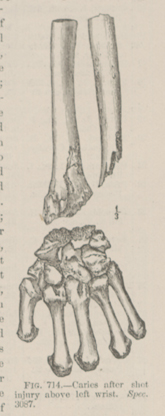Title: Fowler, H.C.
Source text: The Medical and Surgical History of the War of the Rebellion. (1861-65.), Part 2, Volume 2 (Washington, DC: Government Printing Office, 1876), 985.
Civil War Washington ID: med.d2e31365
TEI/XML: med.d2e31365.xml
CASE 1928.—Private H.C. Fowler, Co. H, 7th Michigan, aged 22 years, was wounded at Deep Bottom, July 26, 1864, and sent to Lincoln Hospital, Washington. Acting Assistant Surgeon A. F. A. King reported: "The ball entered on the dorsal aspect of the wrist joint, fracturing it and the ulna. Some splinters were extracted on the field. Abscesses extended up the forearm, and, August 15th, amputation was performed at the middle third, eight ligatures being applied. August 17th, stump considerably swollen up to the elbow; discharge scanty. Applied flaxseed poultice. 18th, swelling less; pus discharging abundantly. 20th, complains of night-sweats. Prescribed solution of quinine with elixir vitriol and McMunn's elixir of opium three times a day. 21st and 22d, still doing very well in every respect; no night-sweats; appetite not very good. Treatment the same, with aromatic fluid extract of cinchona three times a day, also a dose of castor oil to open the bowels. 23rd, had a severe chill at three o'clock P. M.; arm somewhat swollen; pulse frequent; skin hot. Ordered quinine two grains every two hours. 24th, erysipelas; limb red and œdematous up to the shoulder. Gave muriated tincture of iron ten drops every two hours, and quinine every three hours. 25th, swelling increased. Patient in good spirits though rather weak and feverish. A puny fluctuating tumor was opened to-day just above the elbow, and contained serum but no pus. Solution of sulphate of iron applied over the arm. 26th, had another chill; arm no better. Patient slightly delirious toward evening. Continued quinine, iron, and stimulants, and ordered tincture of iron and iodine for the arm. 27th, arm less swollen; pus discharged mixed with serum. 28th, arm much better. Patient complains of pain in right breast and has cough. Treatment the same, with cod-liver oil. 30th, had repeated pyæmic chills yesterday and to-day; skin looks yellow, cheeks flushed; great dullness over lower right lung; pain and tenderness over liver; pulse very frequent and weak; delirium at night. Ordered sulphate of quinine five grains, and chlorate of potassæ ten grains every three hours, also brandy egg-nog. 31st, the arm is not much swollen. It has much improved, although the patient is dying of pyæmia. He has great shortness of breath and is partly unconscious all the time. Treatment continued. September 1st, died at one o clock P.M." A preparation of the bones of the amputated forearm, represented in the adjacent cut (FIG. 714), was contributed by Acting Assistant Surgeon H. M. Dean, who made the following report of a post-mortem examination: "The patient was considerably emaciated and of a sallow color. On examining the stump, the tissues were found to be infiltrated with pus. Pus was also found in the elbow joint. The periosteum was readily separated from the bones of the stump. On opening the thoracic cavity the right side was found to contain about twenty-four ounces of opaque fluid, and the lung was covered by a layer of recently deposited lymph. The lower lobe of each lung was carnified, and contained several isolated abscesses about the size of peas. The right lung weighed twenty ounces, the left thirty ounces. The spleen weighed twelve and a half ounces and contained several small isolated abscesses. Pericardium very much thickened and firmly attached to the walls of the heart. Each side of the heart contained a firm yellowish clot; the organ appeared normal. Liver normal, and weighing seventy-six ounces. Both kidneys were very large, but appeared normal, each weighing eight ounces."
